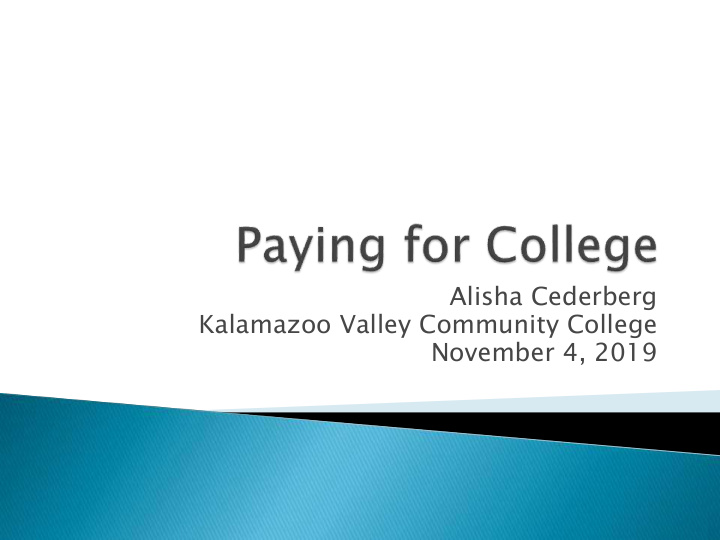



Alisha Cederberg Kalamazoo Valley Community College November 4, 2019
Direct costs ◦ Tuition and Fees ◦ Room and board ◦ Books Indirect costs ◦ Living expenses ◦ Travel
Established by the institution Includes direct and indirect costs Helps establish financial need
Cash, Check, or Credit Card Employer Benefits / Employer Scholarships 529 Plans ◦ MESP – Any Eligible College / University ◦ MET – Can be used outside MI, but will pay average MI tuition and fees for contract amount Payment Plans ◦ Pay amount owed to college in installments during the semester (usually 3-4 monthly payments)
Biggest Source of Scholarships: ◦ The College you are attending! ◦ Qualifying as an incoming freshman Examples: ◦ WMU Medallion Scholarship ($15,000 / 4 years) ◦ GVSU Presidential Scholarship ($7,000 / 4 years) ◦ MSU Honors Excellence Scholarship ($13000 / 4 years)
Must “apply to…” Can be confusing CSS is not required for most colleges FAFSA and Scholarship applications take student initiative (outside of freshman admissions scholarships are usually required if seeking funds).
Financial aid consists of funds provided to students and families to help pay for postsecondary educational expenses ◦ Federal funds ◦ State funds ◦ Institutional funds ◦ Private funds
FAFSA ◦ FREE Application for Federal Student Aid Available through Mobile App: myStudentAid App Available Online ◦ www.fafsa.gov ◦ Also sometimes called “FotW” (FAFSA on the Web) Must Renew FAFSA each school year
May be filed at any time during an academic year, but no earlier than October 1 st prior to the academic year for which the student requests aid Most colleges set FAFSA filing deadlines for scholarships FRE REE E – canno not t em emphas hasize ze this s en enough ugh …the FAFSA will not ask for your credit card number
FAFSA is available at www.fafsa.gov “Skip technology” simplifies the application You will know the answer to almost all of the questions Only one question you cannot answer incorrectly: The Student’s Social Security Number!! (schools and families can update and fix everything else).
The FAFSA asks a series of questions to determine if a student is independent or dependent. Dependent students will need to include parent(s) information on the FAFSA Dependent students will also need parent(s) to sign the FAFSA
If the parents rents have ve divor vorced ced or separated: arated: Answer the questions about the parent you lived with more during the past 12 months If exactly equal time, who provides most support? NOT: * who claims student on taxes * who will result in highest eligibility If this is parent rent has remar married ried as of toda day, answer the questions about both that parent and the person to whom the parent is married (ie... Step parent)
2018 Tax information Cannot/should not update to 2019 taxes IRS Data Retrieval – if successful, information will not be displayed to family/student Tax Returns with Schedules Tax Transcripts Verification of Non-Tax Filing
You will sign the FAFSA using your FSA ID FSA ID is also how you login to myStudentAid ◦ https://fsaid.ed.gov ◦ Unique to your SSN ◦ Unique to your email address ◦ Cannot be shared! ◦ Parents of dependent students will have their own FSA ID ◦ Only the owner should create a FSA ID
Verification Authorization Loan requirements Register with Selective Service
The FAFSA is used to calculate Expected Family Contribution (EFC) EFC determines eligibility for the federal Pell Grant COA – EFC=financial need
Grants Scholarships Work programs (work-study) Loans
Free money! Federal Pell Grant is the biggest source of grant money ◦ Eligibility is based on the EFC determined by the FAFSA ◦ Maximum award for 2019-2020 is $6,195 ◦ Is limited to 6 years (or the equivalent of 12 full- time semesters SEOG – priority to Pell Grant recipients Institutional Grants
Free money Usually requires a separate application as determined by the donor ◦ FAFSA is often required ◦ Many state scholarships require a specific FAFSA submission date Scholarships can be local, national, institutional, regional… Always check with employers for tuition reimbursement Student is responsible for researching, applying
Work-study programs (federal and institutional, no state funds) Self-help program that provides on-campus (and sometimes off-campus) employment to eligible undergraduate and graduate students Each institution determines awarding rules and priorities for work-study dollars
Federal Direct loans ◦ Subsidized ◦ Unsubsidized Parent PLUS Loan for parents of dependent students Graduate PLUS Loan for graduate students Private/alternative loans
Subsidized ◦ Low-interest loans for financially need undergraduate students ◦ Interest does not accrue while the student is in school ◦ Limited based on grade level, financial need, and time spent completing your program Unsubsidized ◦ Low-interest, not need-based ◦ Dependency status/grade level determines eligibility
Amount determined by grade level, dependency status: ◦ Dependent Freshman qualify for $5500 ($3500 can be subsidized) ◦ Independent Freshman qualify for $9500 ($3500 can be subsidized)
Tuition Incentive Program ◦ For students who received Medicaid coverage for 24 months within a 36 month period ◦ Phase I: Covers in-district costs of tuition and mandatory fees for associate degree/certificate program at Community College ◦ Phase II: Provides $2000 tuition assistance at an eligible in-state four-year college/university Michigan Competitive Scholarship: $1000
You must be admitted as a regular student into an eligible program Keep applying and looking for scholarships (within the college, in your community) Check with your institution ◦ Award letter ◦ Requirements to complete financial aid eligibility ◦ Requirements may vary from college to college ◦ Requirements/next steps may be fund specific
Complete a FAFSA each year ◦ 2021-2022 FAFSA available October 1, 2020 Attend classes, pass classes Continue scholarship search
Answers? Alisha Cederberg acederberg@kvcc.edu 269.488.4231
Recommend
More recommend